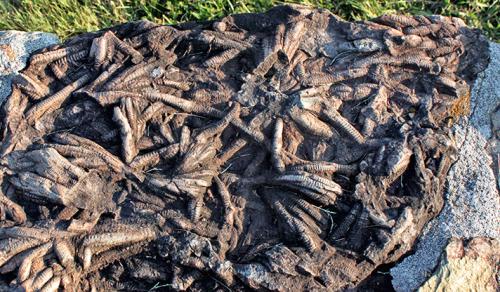
Earth’s early burrowers were slow to discover the bottom of the ocean as a good place to kick up dirt.
New research suggests that ancient marine animals took millions of years longer to stir up the sea floor than previously thought. The timing has implications for the chemical composition of Earth’s early oceans and atmosphere, and for the formation of ocean ecosystems.
The process of mixing sediments by burrowing animals is known as “bioturbation.” It is a hallmark of the modern ocean floor, shaping the ecological character of marine environments around the world. For years, scientists thought bioturbation commenced in earnest with the Cambrian Explosion, 541 million years ago, when the complexity and diversity of animal species began to expand dramatically.
But that wasn’t the case. In a new study published in the journal Nature Geoscience, researchers found that major bioturbation did not occur until at least 120 million years later, during the late Silurian Period.
“We found it particularly intriguing that although burrowing animals colonized seafloor sediments very early in animal history, there was such a substantial lag between colonization and intensive, modern-style sediment mixing,” said Lidya Tarhan, a postdoctoral associate at Yale and lead author of the study.
Tarhan and her colleagues based their analysis on extensive fieldwork in the United Stated, Canada, Spain, and Australia. The team studied trace fossils — the trails, tracks and burrow marks left behind by animals — and sedimentary conditions under which the trace fossils were formed and preserved. The research team concentrated on a single type of environment, the shallow ocean seafloor.
“No previous study had ever attempted to do all these things,” Tarhan said. “It was our multi-pronged approach that yielded unprecedented insight into what was previously a largely intractable question: When and by what means and how rapidly did burrowing animals start to engineer the seafloor?”
Among the burrowing animals responsible for this record were trilobites, crustaceans, and a variety of worm-like creatures.
The researchers also propose that delayed bioturbation may have been responsible for regulating marine sulfate and atmospheric oxygen levels. A previously proposed drop in surface oxygen levels may be tied to the onset of extensive bioturbation, given that “oxygen is directly tied to the burial of organic carbon,” Tarhan said. “Less burial of organic carbon, due to bioturbation, means that more oxygen is used to respire or burn through that carbon, and thus oxygen decreases.”
Additional co-authors of the study are Noah Planavsky, a Yale assistant professor of geology and geophysics; Mary Droser of the University of California-Riverside; and David Johnston of Harvard.